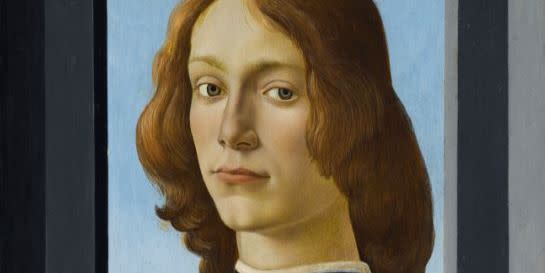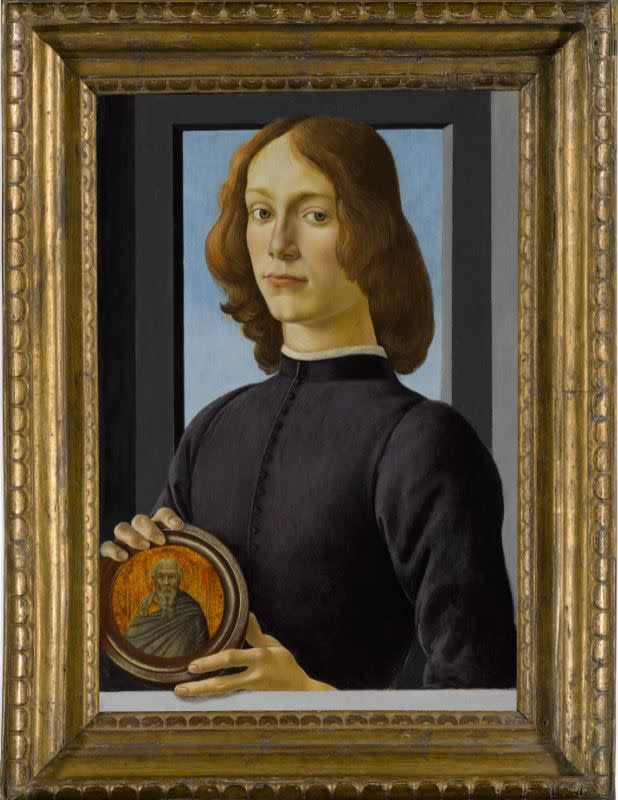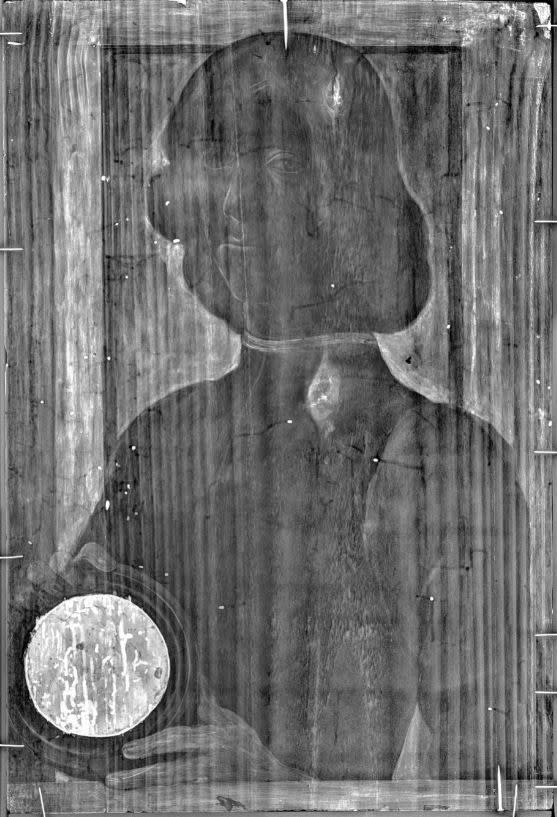Sotheby’s is Selling the Ultimate Renaissance Painting

After Botticelli’s Portrait of a Young Man Holding a Roundel arrived at Sotheby’s and acclimated to the humidity levels, it was unpacked from its crate, taken out of its frame, and laid down on a table in the scientific research lab. When I was allowed to visit, I stood above the painting, which is estimated to sell in excess of $80 million, too scared to even breathe in its vicinity. The young man depicted on the panel stared back at me.
I had previously seen him hanging in the Metropolitan Museum of Art. After I had locked eyes with him across the quiet gallery, I felt his steely gaze follow me across the room, chastising me like a security guard when I got too close. But when I encountered him at Sotheby's, his demeanor did not seem quite as haughty. Looking down at him, I admired his softly waved hair, his piercing eyes, his faint smile. Seeing him from above, his gaze did not come off as quite so piercing. It is the endless array of expressions offered by the young man’s finely modeled face that make this portrait a masterpiece unlike any other that has been offered for auction in recent years.
Sandro Botticelli (born in Florence in 1444 or 1445 as Alessando di Mariano Filipepi) was one of the most famous artists of the Italian Renaissance. While today he is known for his mythological masterpieces hanging in the Uffizi Gallery in Florence and his religious frescoes that decorate the churches of the Tuscan city, he was sought out as a portrait painter by some of the most famous Italians of his era.
His portraits are not as famous today—few tourists make pilgrimages to see them, as they do to stand in front of his Birth of Venus at the Uffizi—but that is largely because so few of them have survived. There are only about a dozen extant portraits by the artist, and nearly all are in museum collections. (This one has been hanging in museums for the past two decades, first the National Gallery in Washington and then at the Metropolitan Museum of Art in New York City.) When this portrait is sold during Sotheby’s Master Paintings auction on January 28, it could very well be the last time a portrait by Botticelli will be available on the art market—and it will almost certainly be the last chance to own a portrait of this caliber.

Last sold in 1982, this painting has a long provenance and history, though the identity of its sitter has been lost to history. The panel was painted between 1480 and 1485, and in the past, it has been suggested that the subject could be Giovanni di Pierfrancesco de’ Medici, the cousin of Lorenzo de’ Medici, who was the de facto ruler of Florence until his death in 1492. Known as Lorenzo the Magnificent, he was an important patron of Botticelli and a number of other artists and scholars of the Renaissance, including Michelangelo and Leonardo da Vinci. Even if the young man depicted is not Giovanni, scholars can say with near certainty that the sitter was a member of the Medici family or someone from their close circle.
While the identity of the sitter remains elusive, some of the panel's other secrets were revealed to us through scientific analysis. Through X-rays and Infrared Reflectograms (IRR) taken of the painting in our lab, we were able to see how the artist adapted and developed the pose of the subject as he worked on the painting. Despite the apparent clarity and certainty of every line in Young Man Holding a Roundel, the IRR images we took show the structure of incised circles and lines that are characteristic of Botticelli’s method of plotting out his compositions. They also reveal extensive underdrawings that differ in many details from the finished painting, including changes to the sitter’s hair, which was lengthened to his shoulders, and adjustments to the collar and buttons of his tunic.

The mysteries inherent in each panel and canvas are what make Old Master paintings so beguiling. One of the most important details of the painting is the roundel that the young man holds. Unlike similar symbolic items, which were usually painted in the hands of those sitting for portraits during the Renaissance, the object that the young man holds is an original 14th-century work attributed to the Sienese painter Bartolommeo Bulgarini, which was inserted into the panel on which Botticelli painted this portrait.

If the medal was original to the portrait, it must have revealed something symbolic about the sitter—perhaps he shared a name with the saint, or saw the man in the roundel as his patron saint. But more tantalizing is the idea that the object served as a vanitas object that represented the passage of time and the transience of the material world. In the same way that skulls and ancient ruins depicted in paintings served as reminders of both the greatness of antiquity and of our own ephemerality, this medal, which was painted only a century earlier, but before the advent of the Renaissance and in an entirely different style, may connote how quickly our perception of the fragile masterpiece could change and, most importantly, the temporality of both the sitter and his beholders.
In writing about Renaissance portraiture in his seminal book Ways of Seeing, the art critic John Berger explained, “The surface verisimilitude of oil painting tends to make the viewer assume that he is close to—within touching distance—of any object in the foreground of the picture. If the object is a person, such proximity implies a certain intimacy. Yet the painted public portrait must insist on a formal distance. It is this—and not technical inability on the part of the painter—which makes the average portrait of tradition appear stiff and rigid. The analogy is with specimens under a microscope. They are there in all their peculiarity and we can study them, but it is impossible to imagine them considering us in a similar way.”
However, it is impossible to look at the present portrait and not imagine the subject considering us. Not only does his gaze play with ours, but his body interacts with ours as well. The deceptively simple background relies on fictive constructions to create an illusion of three-dimensionality that draws our eye into the space occupied by the sitter, and the young man’s fingers do not just sit in the foreground of the panel but instead cross over the pictorial boundary and enter our realm, encouraging our intimacy.
It has been 550 years since Botticelli painted this masterpiece, and the young man still looks as if he could easily reach out and touch us. He is isolated in the architectural framework behind him like a jewel in a box and painted in a limited palette of colors, but he reveals plenty of information about himself through the details of his portrait. His choice of a simple black costume of the highest quality tells us that he doesn’t need to rely upon jewels, rich fabrics, or a sumptuous background to display his wealth. Instead, he relies on the blue background behind him to connote his status; his contemporaries would have known that the background was painted with the precious blue pigment ultramarine, which was as expensive as gold.
In his 1435 treatise On Painting, the Italian author Leon Battista Alberti celebrated the medium for its capacity to “make the dead after many centuries almost come to life.” Few paintings can rival the present work's ability to do so because not only are we able to connect intimately with the young man before us through his image, but we can also listen to him and learn from him through the details in the panel itself, which have been hidden for centuries but have only recently come to light.
You Might Also Like
